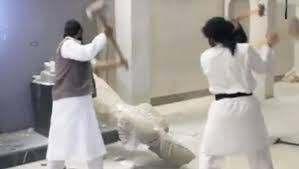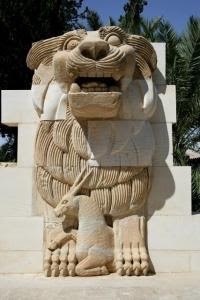Syria: ISIS Palmyra Demolition has begun with Ancient God Lion Statue destroyed

By Nour al-Rafee
When Islamic State (Isis) took over Palmyra last week, the jihadists assured the world they were not going to destroy the ancient city’s treasure trove of ruins and artefacts.
According to the Palmyra Media Centre, “IS militants promised the citizens during a talk that they won’t offend the ancient city [sic]”. This claim has been repeated in interviews with several media outlets.
However, it seems the strategy has now changed. On Wednesday (27 May), a Syrian radio station broadcast a declaration from an alleged IS commander in Palmyra claiming the group will “destroy statues” representing idols but preserve the historical monuments and the ruins.
In fact the process of obliterating the horde of ancient statues has already begun. It commenced almost as soon as the militants seized control of their quarry.
Two days after IS seized control of Palmyra, one citizen witnessed militants crushing statues in the city’s museum. He says: “I heard a loud noise, so I went up to the roof to see what is going on. I saw Daash [Isis] crushing the “god lion” statue with construction machines. There were many other crushed statues but I could not recognise the rest of them because they were totally ruined.”
 The ‘god lion’ statue allegedly destroyed by Isis – Wikipedia
The ‘god lion’ statue allegedly destroyed by Isis – Wikipedia
The god lion, or to give it its full title, the Lion of Al-Lat, dated from the first century AD.
It stood at the entrance to the ancient Bel’s Temple, and was built in homage to the goddess Al-Lat, a pre-Islamic Arabian goddess who was one of the three chief goddesses of Mecca, and is mentioned in the Quran.
It is forbidden for people to enter the area of ruins which became military strongholds for the IS militants, as another local resident, Abo Ali, explains:
“After Daash took control in Palmyra they prevented citizens from entering the ancient city. They promised us that they are not going to destroy any of it, but we knew that they would not keep their promise.
“As we expected they have actually destroyed one of the most important places in the city, the museum, and I guess they will continue doing this.”
The ancient city of Palmyra is not just important to the local inhabitants, but also for Syria and the wider world. It is considered a focal point of regional tourism and one of the most important archaeological sites in the Middle East.
Yet the people of Palmyra, as well as having to suffer under the yoke of IS occupation, are worried they will lose this inheritance, which has survived the ages and witnessed several different cultures.
A local resident known simply as Hamza says: “It is very hard on us to see the city collapsing after all this time. We grew up watching and loving our ancient city, which was always full with people and tourists coming over from all around the world. This is our legacy.”
Nour al-Rafee is a Syrian journalist who works for Al-Alaan. She has family in Palmyra.
Copyright Nour al-Rafee, International Business Times 2015

